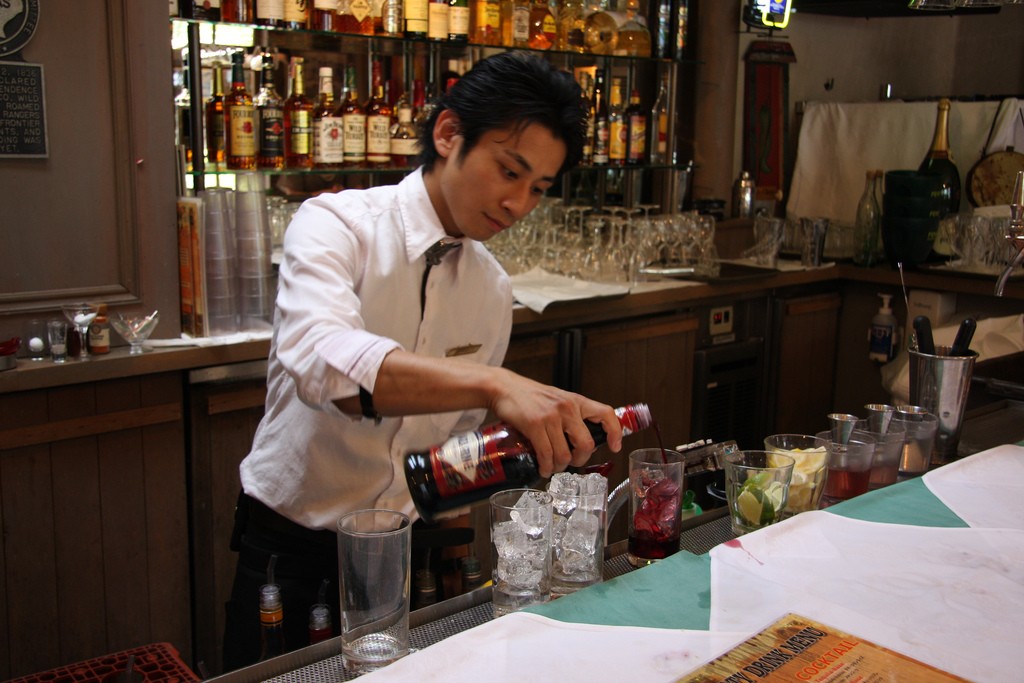Though turning a profit at your business includes many details, increasing your cash flow can really only be done in two ways: bringing more customers in, and/or selling more to the customers you already have.
On the TallyFi blog, we’ve already discussed ideas for attracting more customers to your nightclub and we’ve examined how hospitality training can help you keep happy customers. The next step is to nudge those happy, paying customers to spend more money at your bar. How can you do that? Upselling.
Upselling can be defined as selling more to your existing customers. While that may include ensuring that they return to your business over the long-term, upselling focuses on encouraging customers to spend more money each time that they visit.
Even if you’re heavily involved with customer facing during peak hours, the most powerful resource you have for upselling is your service staff. With a few key tips in place, you can develop a strong plan of action for upselling and make sure that your team is ready to go all-in on that plan. Here’s how to do it:
1. Communicate with your team about sales priorities
The first step in motivating your team to upsell is to clearly outline what you expect of them. This is important because some business owners will make the mistake of simply encouraging their team to “sell more.” Not only is this command rather vague, it can also make your staff feel left out of the thought process behind this new initiative, making your goal much more abstract to them.
If you think that this step can be skipped over, remember these statistics found by Blackhawk Engagement Solutions: “Only 40% of employees are well informed of their company’s goals, strategy, and tactics.” Blackhawk also found that these disengaged employees cost the economy an average of $300 billion per year. Furthermore, they claim that “properly structured incentive programs can increase employee performance by as much as 44%.”
Something as small as keeping your employees informed can boost their performance and make them truly care about your goals. It empowers them to help you achieve your goals and, from a purely practical standpoint, it clearly outlines which inventory items need to be sold.
One simple, but extremely effective, step you can take is to have a nightly “stand-up” meeting before you open. It can be as simple as gathering your employees for five minutes and outlining the sales priorities for that night. This allows you to keep your employees updated on your inventory and sales goals, especially if these goals pivot slightly from night to night or week to week. A nightly stand-up can also unify your employees, alert you of any issues on the floor, and promote a sense of focus among the team.
2. Train your staff to make upselling part of their routine
Even the most outgoing employees may feel uncomfortable with the idea of pushing sales on customers. Especially because employee tips are heavily influenced by the customers’ experiences, you may experience some hesitancy when you introduce the idea of upselling.
This can be combatted with proper training and — more specifically — training that makes upselling just another part of your employees’ routines. A few key factors will help your staff meet their upselling goals while actually improving their customer service skills. Some of those factors, courtesy of Buzztime, include:
- Knowing the customer. This is particularly important for recurring customers. Train your staff to build a rapport with bar guests and to get to know their personal preferences. When customers know that they are remembered, they are more likely to enjoy their experience, spend more money, and keep coming back.
- Making the upsell appealing. Most customers don’t like pushy salespeople. However, most people want to know about good deals for things they already enjoy buying. Knowing the customer will work wonders for this, and so will regular training. Try introducing mock scenarios that allow your employees to practice their selling tactics on each other.
- Watching for customer cues. By being observant of customers, your employees can identify which ones are open to upselling and which ones simply are not. They can pay attention to the type (and price) of drinks that the customers order, and they can test reactions to questions like, “Would you like to know more about our specials this evening?” These can help pinpoint upselling opportunities as well as give them a warning flag for customers who aren’t interested.
- Giving customers time to pay. Some servers are in a big hurry to rush their current customers out the door so that they can start earning tips on the next set. But this approach can push current customers out the door when they would have otherwise spent more money. As a rule of thumb, all of your employees should at least ask their customers if they’re interested in another round of drinks before they close the bill.
- Knowing the menu inside and out. We mentioned the importance of this step above, but it’s such a crucial piece of upselling that we’ll mention it again. Your staff needs to thoroughly know the menu. This well help them not only answer customer questions, but it will also give them an edge when suggesting items to their customers.
And, as with everything, customer service goes an extremely long way here. According to Help Scout, loyal customers are worth up to 10 times as much as their first purchase. Even if customers don’t buy more today, leaving them a positive, lasting impression can help your nightclub’s numbers over the long run.
3. Set clear goals — and track them diligently
A key part of boosting upselling is to set clear goals and clearly communicate them to your team. The follow-up is to measure those goals each night. What’s more: You need to measure them objectively. Even a night that felt busy and profitable may have been a total bust in terms of upselling.
One way to do this is to measure the sales of each server for each of their shifts. Even if you don’t start doing this until after you’ve introduced upselling goals, you can use these numbers to gain insight regarding your team’s upselling performance over time.
This is a fine line to walk, however, as too much micromanagement can leave your employees feeling discouraged. What you don’t want to do is sit down with your employees every single night and go over every minute detail of the numbers in an accusatory way. After all, the American Psychological Association found that, when employees feel valued by their employers, 91% of them felt motivated to do their best.
Instead, look at employee performance in terms of trends. Sure, there are bound to be a few nights here and there where upselling just didn’t work out. But, as you help an employee perfect their upselling techniques, you should see those sales slowly increase over time.
Writers at Entrepreneur encourage managers to “hire good people, treat them right, empower them,” and to “hire the best people you can find . . . then treat them as well as you can.” So, as you watch the numbers and have “data check-ins” with your employees, remember to support them after an off night and to acknowledge their success when their upselling trends start to climb.
4. Offer incentives for successful upselling
Listening to your employees and encouraging them every step of the way will work wonders in terms of getting them on board with your goals. In addition to talking to (and listening to) your employees, implementing an incentive program can be a fun way to keep your team motivated.
One thing to keep in mind is that most of your staff will be on board with upselling when you remind them that more sales will likely mean more tips. But, as tip increases can’t be guaranteed, it’s important to offer incentives that are within your control.
Here are some starting principles for introducing incentives:
- Identify your goals, whether that’s getting your team to sell more of a certain product or encouraging them to hit a certain sales number for the night. Relay those goals to the team, perhaps in your nightly stand-up.
- When your team meets those goals, publically congratulate them. If certain employees were stellar performers, call them out. Combine this public recognition with your regular data check-ins, and soon you will be building a sales culture.
- These congratulations don’t have to come in the form of money. For some of your employees, the words of appreciation will mean more than you know. For others, consider frugal incentives, like a company outing at the end of a successful month.
Along with individual incentives, consider offering team-wide incentives. While focusing on tips can be very individualistic, focusing on meeting upselling goals as a team can encourage collaboration and cooperation.
Combining a variety of methods for recognizing your employees will help all of them feel appreciated. By being open about your goals to the entire team and then acknowledging those goals again in a group (as well as one-on-one with employees), you are reinforcing your company goals and arming your team with the motivation to achieve them.
Use Data to Improve Company Culture and Increase Sales
By tracking your nightclub’s sales and analyzing key factors like nightly revenue, sales per guest, and sales per employee, you can keep track of how well your training and incentive programs are improving your bottom line.
TallyFi, a guest counter that automatically tracks these metrics and syncs them to the cloud, can play an integral role in your quest to boost upselling at your bar. Have better conversations about employee performance, pinpoint weak spots in your sales, and track the data behind your upselling tactics — all without fussing with a spreadsheet.



